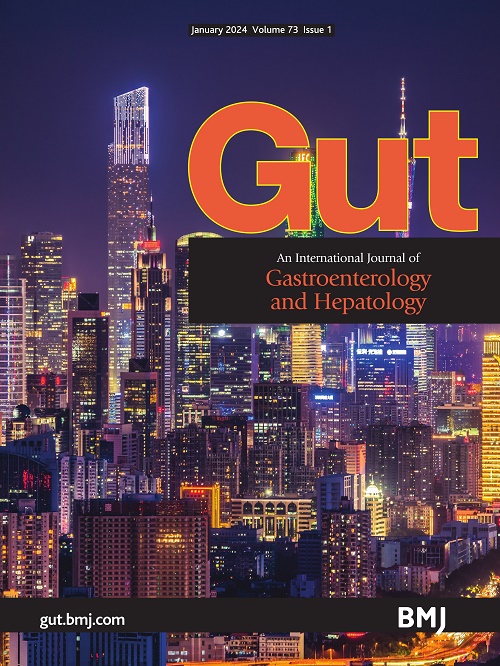酒精相关肝炎:嗜中性粒细胞疾病?
IF 23
1区 医学
Q1 GASTROENTEROLOGY & HEPATOLOGY
引用次数: 0
摘要
酒精相关性肝炎(AH)是酒精相关性肝病(ArLD)的急性恶化,黄疸迅速出现或加重,严重者可转变为急性-慢性肝功能衰竭(ACLF),短期死亡率极高,并随着肝脏和肝外器官功能障碍的数量和严重程度而增加。全身性炎症是导致急性失代偿(AD)发展为 ACLF 的标志。由于其发病机制复杂、多因素且尚未完全明了,因此诊断和治疗既不充分又极具挑战性。在 AH 患者中,这种炎症的特点是循环和肝脏中性粒细胞水平升高,而中性粒细胞是负责病原体防御的重要免疫细胞。然而,中性粒细胞在 AH 中的确切作用仍存在争议,人们一直在争论中性粒细胞的过度激活是会加重肝损伤还是有助于缓解病情。目前对 AH 的治疗主要依靠类固醇,但仅限于细菌感染病例。因此,临床上需要更好地了解 AH 和相关器官功能障碍的发病机制。此外,细菌感染的早期发现和治疗对于改善患者预后至关重要。1 长期饮酒与肠道菌群失调有关,导致细菌、病毒和真菌的组成发生改变。研究发现,一些细菌代谢产物可促进肝病的恶化。其中,由粪肠球菌分泌的内毒素细胞溶解素与更高的肝脏炎症和更高的 AH 患者短期死亡率有关。本文章由计算机程序翻译,如有差异,请以英文原文为准。
Alcohol-associated hepatitis: a neutrophile disease?
Alcohol-associated hepatitis (AH) is the acute deterioration of alcohol-related liver disease (ArLD) with rapid onset or worsening of jaundice, which, in severe cases, may transition to acute-on-chronic liver failure (ACLF) with extremely high short-term mortality, increasing with the number and severity of hepatic and extra-hepatic organ dysfunction. Systemic inflammation is a hallmark, driving acute decompensation (AD) towards ACLF. Diagnosis and treatment are insufficient and challenging, especially due to the complex, multifactorial and as yet not fully understood pathogenesis. In patients with AH, this inflammation is characterised by increased levels of circulating and hepatic neutrophils, which are essential immune cells responsible for pathogen defence. However, the exact role of neutrophils in AH remains controversial, with ongoing debate over whether their hyperactivation exacerbates liver damage or helps to resolve the disease. Current treatment for AH primarily relies on steroids, but their use is restricted in cases of bacterial infections. Consequently, there is a clinical need to better understand the mechanisms underlying AH and the associated organ dysfunction. Moreover, early detection and treatment of bacterial infections are critical to improve patient outcomes. These challenges, coupled with its rising prevalence in Germany and other Western countries, highlight a significant gap in patient care.1 Chronic alcohol consumption is associated with gut dysbiosis, leading to alterations in the composition of bacteria, viruses and fungi. Several bacterial metabolites were identified to foster liver disease progression. Among them, cytolysin, an endotoxin secreted by Enterococcus faecalis, is associated with higher hepatic inflammation and higher short-term mortality in patients with AH.2 …
求助全文
通过发布文献求助,成功后即可免费获取论文全文。
去求助
来源期刊

Gut
医学-胃肠肝病学
CiteScore
45.70
自引率
2.40%
发文量
284
审稿时长
1.5 months
期刊介绍:
Gut is a renowned international journal specializing in gastroenterology and hepatology, known for its high-quality clinical research covering the alimentary tract, liver, biliary tree, and pancreas. It offers authoritative and current coverage across all aspects of gastroenterology and hepatology, featuring articles on emerging disease mechanisms and innovative diagnostic and therapeutic approaches authored by leading experts.
As the flagship journal of BMJ's gastroenterology portfolio, Gut is accompanied by two companion journals: Frontline Gastroenterology, focusing on education and practice-oriented papers, and BMJ Open Gastroenterology for open access original research.
 求助内容:
求助内容: 应助结果提醒方式:
应助结果提醒方式:


